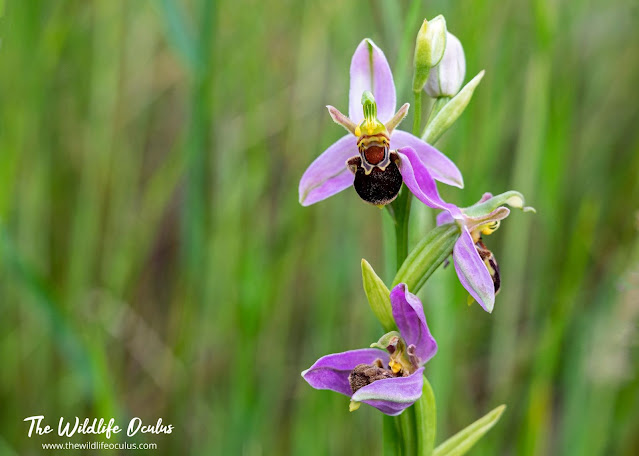Good to bee back
I have been visiting Goldcliff Lagoons a little less frequently this month. Away trips to RSPB Dinas , Skomer and a BTO BBS Survey has been occupying my free time when I have not been working.
The reserve is going through what could be called a bit fo a transition period. The main breeding season for waders is coming to an end.
There is a feeling of a "lull" between the next big migration event - the autumn passage. This period of time generally encompasses the return of species of birds that have bred in the Northern Hemisphere and are returning to their more southerly wintering grounds.
Many of these migrating birds will either Winter in the UK or use it as a stop over before travelling a lot further South. In fact the term "Autumn Passage" is a bit misleading as many species of waders that have bred in the likes of Iceland and Northern Scandinavia , by the end of July and in some cases even earlier, will begin to arrive back at Goldcliff Lagoons.
In the meantime there remains lots of activity at Goldcliff but in general the numbers of different wader species are down and many of the breeders such as Avocets have up and left the reserve. It's a shame but it seems by all accounts that the Avocets have not had a successful breeding season, again unfortunately.
Today I visited the reserve with my friend Paul Joy and met up with John "The Video" Lawton and Nev Davies. The reserve was pretty quiet on the people front but there was lots to keep us interested and entertained.
Nev, and John found a Bee Orchid.What a beautiful plant. The flower really does look like it has a large bee is on it. It is thought that the petals are shaped like this to attract a male bee to the flower to pollinate it. I have read that apparently the "right" species of bee no longer exists in the UK, so instead these orchids self fertilise themselves without any involvement of a bee.
 |
| Bee Orchid (Ophrys apifera) |
I think its fantastic at the moment the the grassland on the reserve is not being mowed or grazed. I have never see the grass so long and it is full of various wild flowers. I wonder if that's why we are seeing amazing plants like the Bee Orchid this year actually on the reserve.
I really like seeing the different species of plant life. Even the grass s fascinating . I bet there are many people out there who have never seen mature grass and just assume its meant to look about 2mm high on a manicured lawn.
 |
| Lovely to see mature grassland |
Once gain I found myself pondering where all the insects have gone. There seems to be a massive drop off in "visible" numbers in the UK. I just don't seem to see the numbers of butterflies that I used to see.
Last weekend I was fortunate to find a patch of grass that a Common Blue and Small Copper Butterfly were feeding on in the flowing grass.
 |
| Common Blue Butterfly |
 |
| Small Copper Butterfly |
These were the first butterflies other than a Small White and a Red Admiral that I have seen properly this year at the reserve.
When Paul and I scanned the grass we found that there were lots of Bumblebees and small flies about. Bumblebees were feeding on grass flowers . They looked too heavy to balance on the very fragile grass but some how they did.
 |
| Bumblebee on a flowering grass stem |
The tide was well out today during our visit. On the mud was a small flock of Shelduck that had a real oddity mixed in with them - a Cape/Ruddy Shelduck. There is some discussion as to what exactly this bird is and whether it is an escapee.
 |
| Cape/Ruddy Shelduck? |
We had a nice little social gathering in the Seawall hide and were amazed at the numbers of Redshanks that had decided it was great idea to perch up on fence posts. At one state there must have been about six or severn at a time perched up the fence that borders the seawall near Becs Lagoon.
A couple of the birds took to perching almost directly in front of the hide.
 |
| Redshank |
There was a commotion around the back of the seawall hide and I was lucky to find a Oystercatcher that had also decided to join the trend and it had perched up on an old stone post on the seawall.
 |
| Oystercatcher |
On Priors and Bec's Lagoon if you look carefully you will find another rarity. A Garganey Duck has been frequenting the reserve now for a couple of weeks. Today it was showing quite well keeping some Mallard and Tufted Ducks company.
 |
| Garganey Duck |
We finished off the visit scanning the long grass bordering the reen's and I found a couple of Blue Tailed Damselflies. Another first insect species for me this year.
I just love the azure blue colour - wonderful.
 |
| Blue Tailed Damselfly |
Once again I had a great morning out with good company as always. The highlight for me was certainly seeing that lovely Bee Orchid. It was good to "bee" back on the reserve.
 |
| Bee Orchid |


Excellent blog as always!
ReplyDeleteThanks You John
Delete